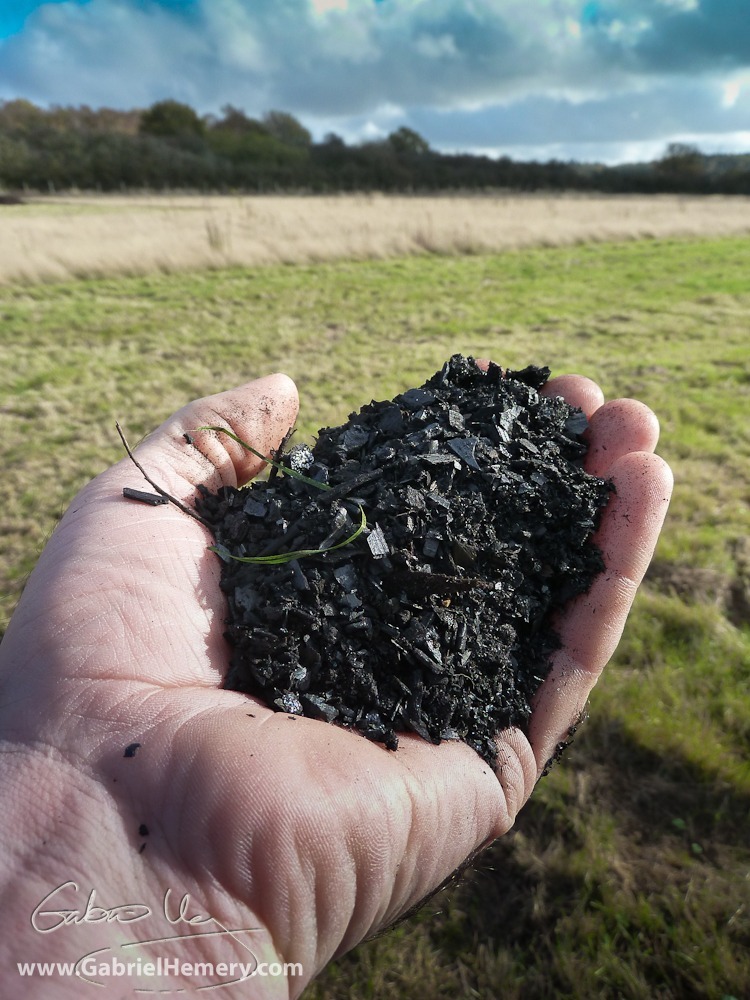Biochar was one of those terms that when first heard left me none-the-wiser. You mean it’s charcoal but with a different name – why’s that? You bury it – that seems a waste, why not burn it? In case it’s a new term to you, here’s a brief overview of biochar.
Biochar – what is it?
Biochar is a plant-based product, generated by heating biomass in the absence of oxygen. It can be made from wood, in which case it is no different in from charcoal, except that producers say the manufacturing process is more efficient and greener with the modern equipment used for biochar production than old-fashioned charcoal kilns. It also differs from charcoal in that it can be made from other plant material including straw, grain, stalks and roots. It is normally of fine size, for example tiny fragments or even dust.
How is biochar made?
By burning in a kiln without oxygen and at very high temperatures, typically over 350°C, the plant cells breakdown with the cellulose and lignin forming amorphous carbon (biochar), CO2, water and some other volatiles. The technical term for this process is pyrolysis.

Biochar – what’s the big idea?
Biochar first surfaced when Peter Read, a research fellow at Massey University in New Zealand, coined the term in 2005 to describe finely divided pyrolysed biomass material prepared specifically for soil improvement. Biochar can improve soil fertility, structure, acidity and water quality, while also reducing the need for fertilisers and watering. Biochar is not a new idea but one based on a technique used by Amazonian Indians to improve soil conditions, where it is called Terra preta.
What really excited environmentalists was the idea that biochar can sequester carbon (capture it). Instead of burning organic material (as in the traditional use for charcoal), if biochar is buried instead then the carbon ‘locked’ in it will be permanently removed from the atmosphere. Therefore, using biochar could in theory help us lower our carbon emissions and prevent climate warming.
Biochar – debate and contention
Biochar has attracted much heated debate. Among its supporters is James Lovelock, the founder of the Gaia hypothesis, while against has been Biofuelwatch, the Organic Consumers Association, and the Rainforest Action Network. One of the most interesting discussions was initiated by a damning article by environmental commentator George Monbiot in UK newspaper The Guardian in 2009. In the defence of biochar, both originator Peter Read and James Lovelock, responded in what turned out to be a fascinating debate.
- Original article by George Monbiot: Tuesday 24th March, 2009
- Response by James Lovelock: 24th March 2009
- Response by Peter Read: 27th March, 2009
“This gift of nature is the best way to save us from climate catastrophe. Biochar schemes would remove carbon from the atmosphere and increase food supply.” Peter Read
“There is an outside chance that one procedure could really turn back the clock on Global warming and that is burying carbon. All you have to do is get every farmer everywhere to make a profit by turning all his agricultural waste into char and burying it. “James Lovelock
Gabriel Hemery
Further reading
- The Biochar Debate: Charcoal’s Potential to Reverse Climate Change and Build Soil Fertility
By James Bruges. 120 pp. Chelsea Green Publishing. (2010) - Oxford Biochar
- Biochar Innovation
 This work is licensed under a Creative Commons Attribution- NonCommercial- NoDerivs 3.0 United States License.
This work is licensed under a Creative Commons Attribution- NonCommercial- NoDerivs 3.0 United States License.

Unlike mychorrizal fungi supplements the lack of solid research renders this as a miracle cure useless. I have seen the results from using biochar in test urban locations in Ile De France, where the results are damning to say the very least. My personal observation is simply that biochar has averted attention away from research into positive and realistic approaches to soil management and thus before any conclusions have been able to be ascertained we have wasted time, effort and considerable money on a nonsense.
Overdosing >80cm top strata soils with potash can be good for some very small very isolated soil communities and the more it is added the better some results – we know from many locations (in the UK& abroad) that the presence of supplementing local soils with open (wood/coal fuel) fire waste increases growth rate of some exotic species at an exceptional rate, much to any TV gardeners delight. But it also destroys soil to an extent where accurate examination techniques are exhausted and it becomes the domain of pseudo Sunday pm TV science instead.
This is where science and the hope for a miracle cure overtakes reality and the fact is that all test locations I know have seen a horrific reduction in organic ‘live’ content, exceeding sites with above average pollutant by dog faeces / urine or even chemical usage!
Biochar simply kills indigenous soils from (at least) Toulouse northwards!
In the desire to plant trees in the UK, the aspirations and lust for that percentage of profit in the ‘average’ cost of planting a single tree, the UK is heading for an almighty car crash. Beating up rates in the UK increase year on year, infant tree mortality is at an all time high, because no one in the UK is prepared to spend any time looking at SOIL.
Therefore before any tampering with the wonderful and exceptional array of soils found in the UK, let’s at least try and understand the soils that exist now, rather than focussing in on ‘perception’ or ‘education’, because unless the trees reach their (minimum) 12 year ‘safety’ age, it will all fail!
In the meantime we go on destroying the tropical rainforest…..
There may well be merit in biochar but branding it a miracle solution destroys it for me – why can’t we keep things simple and just have more trees ? Too simple for the technocrats & attention seekers who seem to dominate so much of the carbon debate ?